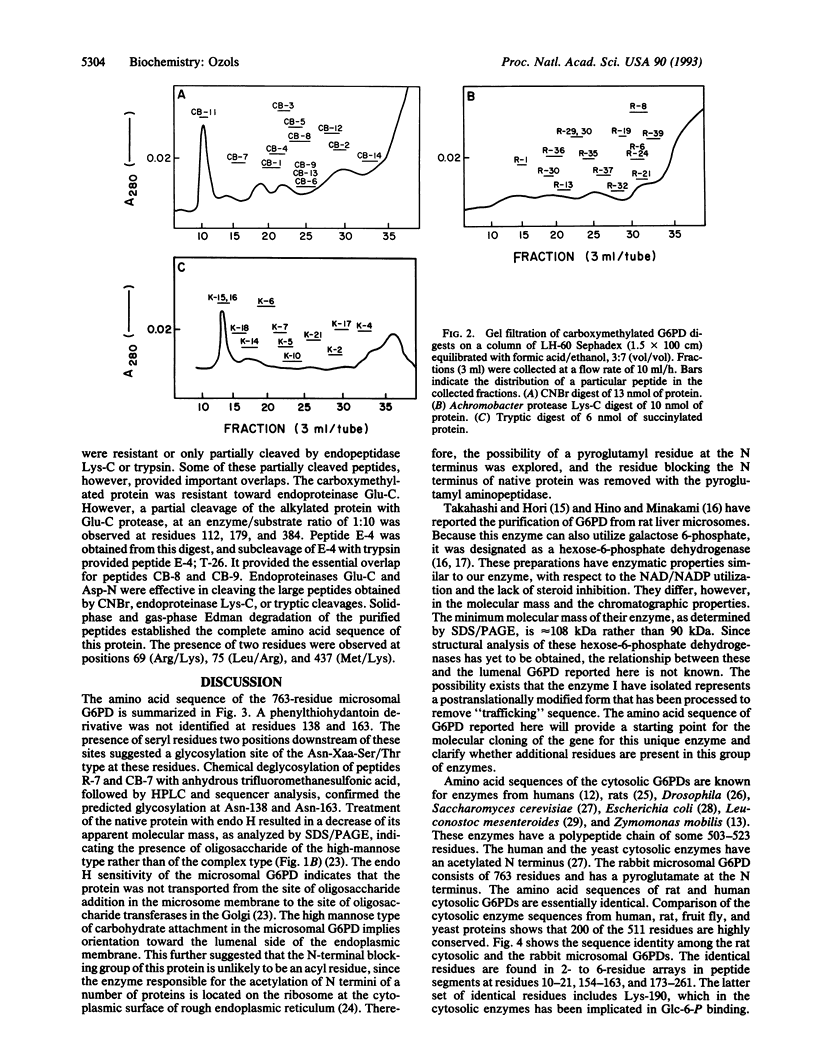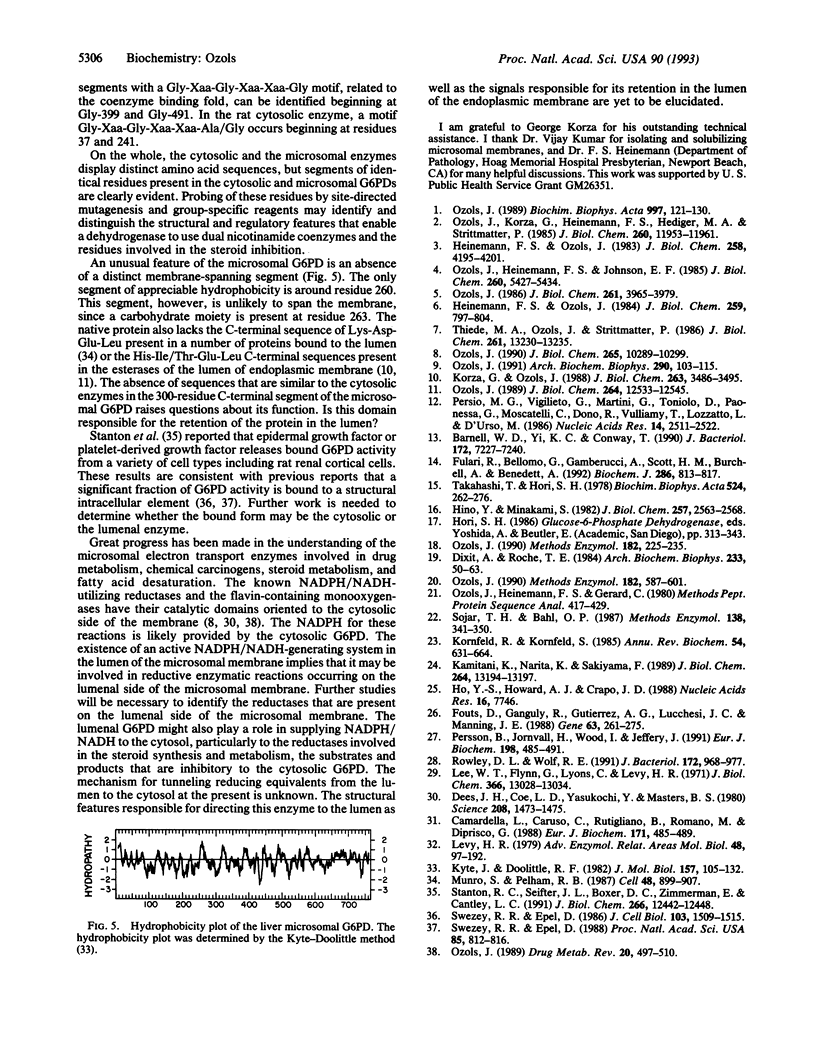Abstract
I have isolated glucose-6-phosphate dehydrogenase from rabbit liver microsomes and determined its complete amino acid sequence. Sequence determination was achieved by automated Edman degradation of peptides generated by chemical and enzymatic cleavages. The microsomal enzyme consists of 763 residues and is quite dissimilar from the previously characterized cytosolic enzymes. The N terminus of the microsomal enzyme is blocked by a pyroglutamyl residue. Carbohydrate is attached at Asn-138 and Asn-263, implying that the bulk of the protein is oriented on the lumenal side of the endoplasmic membrane. The amino acid sequence of the microsomal protein shows limited homology to the extensively sequenced cytosolic glucose-6-phosphate dehydrogenases. Clusters of up to six identical residues can be identified in four regions: peptide segments at residues 10-21, 154-163, and 173-261. In addition, another array of identical residues, requiring a 100-residue deletion in the sequence of the microsomal enzyme, spans residues 436-462 and corresponds to residues 348-373 of the cytosolic protein. Two segments with a Gly-Xaa-Gly-Xaa-Xaa-Gly motif, related to a coenzyme binding fold, were identified at Gly-399 and Gly-491. In the cytosolic enzymes, a variation of this sequence motif occurs at Gly-37 and Gly-241. The 300-residue C-terminal segment of the microsomal enzyme is unique and has no counterpart in the cytosolic or the bacterial enzymes. An unexpected finding with regard to the microsomal enzyme is that it lacks an identifiable membrane-spanning region or the lumenal-protein C-terminal consensus sequences Lys-Asp-Glu or His-Ile/Thr-Glu-Leu. Thus, the mode of transport and retention of this protein in the lumen of endoplasmic reticulum remains to be determined.
Full text
PDF




Images in this article
Selected References
These references are in PubMed. This may not be the complete list of references from this article.
- Barnell W. O., Yi K. C., Conway T. Sequence and genetic organization of a Zymomonas mobilis gene cluster that encodes several enzymes of glucose metabolism. J Bacteriol. 1990 Dec;172(12):7227–7240. doi: 10.1128/jb.172.12.7227-7240.1990. [DOI] [PMC free article] [PubMed] [Google Scholar]
- Camardella L., Caruso C., Rutigliano B., Romano M., Di Prisco G., Descalzi-Cancedda F. Human erythrocyte glucose-6-phosphate dehydrogenase. Identification of a reactive lysyl residue labelled with pyridoxal 5'-phosphate. Eur J Biochem. 1988 Feb 1;171(3):485–489. doi: 10.1111/j.1432-1033.1988.tb13815.x. [DOI] [PubMed] [Google Scholar]
- Dees J. H., Coe L. D., Yasukochi Y., Masters B. S. Immunofluorescence of NADPH-cytochrome c (P-450) reductase in rat and minipig tissues injected with phenobarbital. Science. 1980 Jun 27;208(4451):1473–1475. doi: 10.1126/science.6770464. [DOI] [PubMed] [Google Scholar]
- Dixit A., Roche T. E. Spectrophotometric assay of the flavin-containing monooxygenase and changes in its activity in female mouse liver with nutritional and diurnal conditions. Arch Biochem Biophys. 1984 Aug 15;233(1):50–63. doi: 10.1016/0003-9861(84)90600-3. [DOI] [PubMed] [Google Scholar]
- Fouts D., Ganguly R., Gutierrez A. G., Lucchesi J. C., Manning J. E. Nucleotide sequence of the Drosophila glucose-6-phosphate dehydrogenase gene and comparison with the homologous human gene. Gene. 1988 Mar 31;63(2):261–275. doi: 10.1016/0378-1119(88)90530-6. [DOI] [PubMed] [Google Scholar]
- Fulceri R., Bellomo G., Gamberucci A., Scott H. M., Burchell A., Benedetti A. Permeability of rat liver microsomal membrane to glucose 6-phosphate. Biochem J. 1992 Sep 15;286(Pt 3):813–817. doi: 10.1042/bj2860813. [DOI] [PMC free article] [PubMed] [Google Scholar]
- Heinemann F. S., Ozols J. The complete amino acid sequence of rabbit phenobarbital-induced liver microsomal cytochrome P-450. J Biol Chem. 1983 Apr 10;258(7):4195–4201. [PubMed] [Google Scholar]
- Heinemann F. S., Ozols J. The covalent structure of hepatic microsomal epoxide hydrolase. II. The complete amino acid sequence. J Biol Chem. 1984 Jan 25;259(2):797–804. [PubMed] [Google Scholar]
- Hino Y., Minakami S. Hexose-6-phosphate dehydrogenase of rat liver microsomes. Isolation by affinity chromatography and properties. J Biol Chem. 1982 Mar 10;257(5):2563–2568. [PubMed] [Google Scholar]
- Ho Y. S., Howard A. J., Crapo J. D. Cloning and sequence of a cDNA encoding rat glucose-6-phosphate dehydrogenase. Nucleic Acids Res. 1988 Aug 11;16(15):7746–7746. doi: 10.1093/nar/16.15.7746. [DOI] [PMC free article] [PubMed] [Google Scholar]
- Kamitani K., Sakiyama F. Hen oviduct N alpha-acetyltransferase is a ribonucleoprotein having 7 S RNA. J Biol Chem. 1989 Aug 5;264(22):13194–13198. [PubMed] [Google Scholar]
- Korza G., Ozols J. Complete covalent structure of 60-kDa esterase isolated from 2,3,7,8-tetrachlorodibenzo-p-dioxin-induced rabbit liver microsomes. J Biol Chem. 1988 Mar 5;263(7):3486–3495. [PubMed] [Google Scholar]
- Kyte J., Doolittle R. F. A simple method for displaying the hydropathic character of a protein. J Mol Biol. 1982 May 5;157(1):105–132. doi: 10.1016/0022-2836(82)90515-0. [DOI] [PubMed] [Google Scholar]
- Levy H. R. Glucose-6-phosphate dehydrogenases. Adv Enzymol Relat Areas Mol Biol. 1979;48:97–192. doi: 10.1002/9780470122938.ch3. [DOI] [PubMed] [Google Scholar]
- Munro S., Pelham H. R. A C-terminal signal prevents secretion of luminal ER proteins. Cell. 1987 Mar 13;48(5):899–907. doi: 10.1016/0092-8674(87)90086-9. [DOI] [PubMed] [Google Scholar]
- Ozols J. Amino acid analysis. Methods Enzymol. 1990;182:587–601. doi: 10.1016/0076-6879(90)82046-5. [DOI] [PubMed] [Google Scholar]
- Ozols J., Heinemann F. S., Johnson E. F. The complete amino acid sequence of a constitutive form of liver microsomal cytochrome P-450. J Biol Chem. 1985 May 10;260(9):5427–5434. [PubMed] [Google Scholar]
- Ozols J., Korza G., Heinemann F. S., Hediger M. A., Strittmatter P. Complete amino acid sequence of steer liver microsomal NADH-cytochrome b5 reductase. J Biol Chem. 1985 Oct 5;260(22):11953–11961. [PubMed] [Google Scholar]
- Ozols J. Orientation of microsomal membrane proteins. Drug Metab Rev. 1989;20(2-4):497–510. doi: 10.3109/03602538909103556. [DOI] [PubMed] [Google Scholar]
- Ozols J. Preparation of membrane fractions. Methods Enzymol. 1990;182:225–235. doi: 10.1016/0076-6879(90)82019-x. [DOI] [PubMed] [Google Scholar]
- Ozols J. Structure of cytochrome b5 and its topology in the microsomal membrane. Biochim Biophys Acta. 1989 Jul 27;997(1-2):121–130. doi: 10.1016/0167-4838(89)90143-x. [DOI] [PubMed] [Google Scholar]
- Persico M. G., Viglietto G., Martini G., Toniolo D., Paonessa G., Moscatelli C., Dono R., Vulliamy T., Luzzatto L., D'Urso M. Isolation of human glucose-6-phosphate dehydrogenase (G6PD) cDNA clones: primary structure of the protein and unusual 5' non-coding region. Nucleic Acids Res. 1986 Mar 25;14(6):2511–2522. doi: 10.1093/nar/14.6.2511. [DOI] [PMC free article] [PubMed] [Google Scholar]
- Persson B., Jörnvall H., Wood I., Jeffery J. Functionally important regions of glucose-6-phosphate dehydrogenase defined by the Saccharomyces cerevisiae enzyme and its differences from the mammalian and insect forms. Eur J Biochem. 1991 Jun 1;198(2):485–491. doi: 10.1111/j.1432-1033.1991.tb16039.x. [DOI] [PubMed] [Google Scholar]
- Rowley D. L., Wolf R. E., Jr Molecular characterization of the Escherichia coli K-12 zwf gene encoding glucose 6-phosphate dehydrogenase. J Bacteriol. 1991 Feb;173(3):968–977. doi: 10.1128/jb.173.3.968-977.1991. [DOI] [PMC free article] [PubMed] [Google Scholar]
- Sojar H. T., Bahl O. P. Chemical deglycosylation of glycoproteins. Methods Enzymol. 1987;138:341–350. doi: 10.1016/0076-6879(87)38029-2. [DOI] [PubMed] [Google Scholar]
- Stanton R. C., Seifter J. L., Boxer D. C., Zimmerman E., Cantley L. C. Rapid release of bound glucose-6-phosphate dehydrogenase by growth factors. Correlation with increased enzymatic activity. J Biol Chem. 1991 Jul 5;266(19):12442–12448. [PubMed] [Google Scholar]
- Swezey R. R., Epel D. Enzyme stimulation upon fertilization is revealed in electrically permeabilized sea urchin eggs. Proc Natl Acad Sci U S A. 1988 Feb;85(3):812–816. doi: 10.1073/pnas.85.3.812. [DOI] [PMC free article] [PubMed] [Google Scholar]
- Swezey R. R., Epel D. Regulation of glucose-6-phosphate dehydrogenase activity in sea urchin eggs by reversible association with cell structural elements. J Cell Biol. 1986 Oct;103(4):1509–1515. doi: 10.1083/jcb.103.4.1509. [DOI] [PMC free article] [PubMed] [Google Scholar]
- Takahashi T., Hori S. H. Intramembraneous localization of rat liver microsomal hexose-6-phosphate dehydrogenase and membrane permeability to its substrates. Biochim Biophys Acta. 1978 Jun 9;524(2):262–276. doi: 10.1016/0005-2744(78)90163-8. [DOI] [PubMed] [Google Scholar]
- Thiede M. A., Ozols J., Strittmatter P. Construction and sequence of cDNA for rat liver stearyl coenzyme A desaturase. J Biol Chem. 1986 Oct 5;261(28):13230–13235. [PubMed] [Google Scholar]



